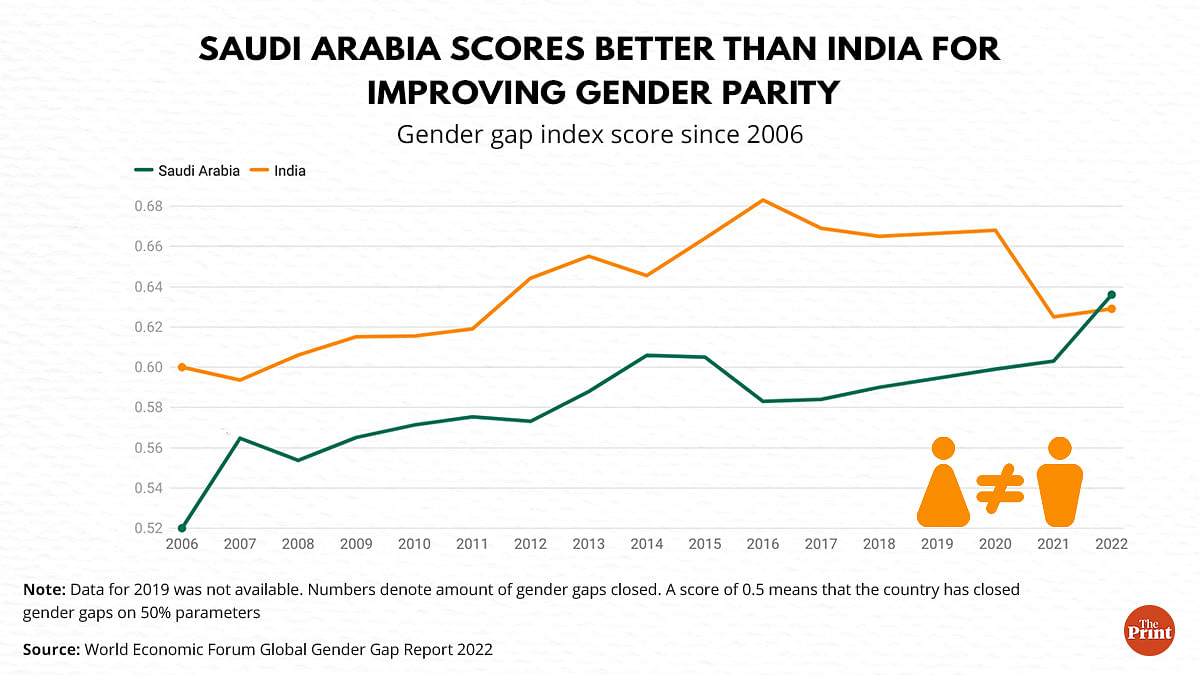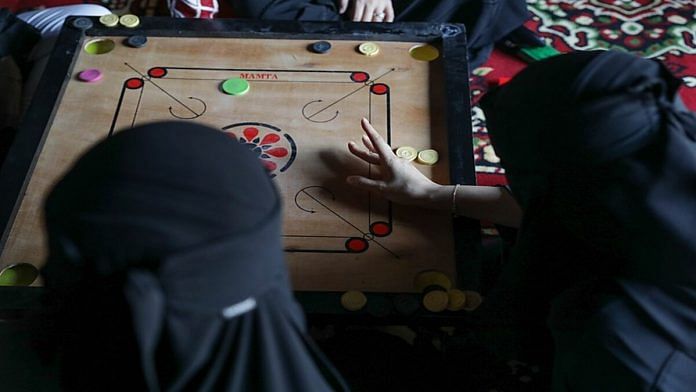New Delhi: Saudi Arabia has outpaced India in bridging the gender gap, the latest Global Gender Gap Index 2022 released by the Switzerland-based World Economic Forum (WEF) shows.
Released earlier this week, the index for 2022 has ranked Saudi Arabia 127th among 146 countries — eight places ahead of India’s 135th.
Saudi scored 0.636 against India’s 0.629, the index shows.
The WEF defines gender gap as the difference between women and men as reflected in social, political, intellectual, cultural, or economic attainments or attitudes.
The index, as described in the methodology section of the Global Gender Gap Index 2022, measures such gaps on four broad parameters (also called sub-indices) — economic participation and opportunities, educational attainment, health and survival, and political empowerment. These are further based on 14 indicators, each of which carries different weight.
The index scores countries from 0-1 for gender parity — 1 being the highest and zero being the lowest.
Interpreted in terms of percentage, Saudi Arabia’s score means that the country has bridged 63.6 per cent of its gender gap, against India’s 62.9 per cent.
Iceland (0.908), Finland (0.860), and Norway (0.845) scored the highest in the index for 2022, while Afghanistan (0.435), Pakistan (0.564) and the Democratic Republic of Congo (0.575) featured at the bottom of the list.
This is the first time that Saudi Arabia — one of the world’s most gender-segregated countries — has outpaced India in the index. The last few years have seen a slew of social reforms for women in the Arab nation, with women granted some rights that were previously prohibited under its strict enforcement of the Islamic law.
India, meanwhile, scored poorly on three of four parameters: last (146) for health and survival, 143 in economic participation and opportunities (just above Iran, Pakistan and Afghanistan), and at 106 (score: 0.967) for educational attainment.

However, it was ranked 48 in political empowerment of women.
Reached for comment about India ranking last on the health and survival parameter, the WEF said the low score was driven primarily “by a lower sex ratio at birth than is biologically the norm, and a healthy life expected ratio of men to women which suggests women are living shorter healthy lives than can be typically expected”.
“With a score of 0.937 on a 0 to 1 scale, India ranks 146th out of 146 economies on the health and survival pillar. This pillar is one which sees a higher concentration of scores, all close to parity,” they said. “There are 28 economies which rank joint 1st at the top end of the scale… This singular measure captures a wide range of possible causes — from disease to higher mortality rates due to other causes”.
Also Read: Does development mean more women in work? Yes in Pakistan but not India, says World Bank study
How Saudi outpaced India
In 2006 — the first time the index was released — Saudi (rank 114) had an overall score of 0.52 (meaning that the country was said to have closed 52 per cent of its gender gap) against India’s 0.6, placing it just above its neighbour Yemen (0.45, rank 115).
According to the WEF index, the country has also shown some progress in women’s participation in the labour force. It scored 0.524 in economic participation and opportunities for women in 2022 — almost twice its score of 0.24 in 2006.
The WEF said bucking the trend of declining women’s participation in the workforce in 2022 was the major reason why Saudi Arabia performed so well.
“In 2022, 129 countries reported a reduction of women’s labour-force participation relative to men’s, which negatively impacted their scores. Three countries saw no changes (Burundi, Rwanda, and Sierra Leone) and 14 reported increased parity in workforce participation — the highest of which was Saudi Arabia, with a 0.097 increase in its gender parity score,” the report said.
Female labour force participation (FLFP) is the percentage of women currently employed or unemployed actively looking for work.
The rise in the women’s work participation in Saudi Arabia has been well-documented: A 2021 study by US-based think tank Brookings says there has been a substantial rise in women’s participation in the Saudi workforce after 2018. The study cited several progressive factors, such as allowing women to drive, change in male guardianship laws, and other laws that restricted women’s mobility, for this increase.
According to the World Bank’s database, Saudi Arabia’s FLFP was 31 per cent in 2021, in contrast to India’s 19 per cent.
India’s gender gap in workplace and economic opportunities hasn’t changed much in the last 16 years, the WEF notes — going from 0.39 in 2006 to 0.35 in 2022.
(Edited by Uttara Ramaswamy)
Also Read: In India’s job market, women have higher exit rate, lower entry rate than men: Study



